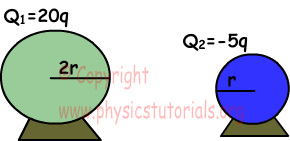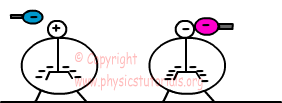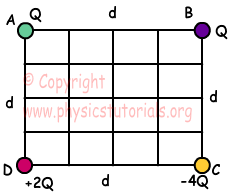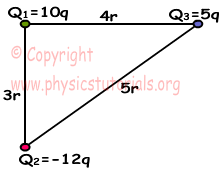Electrostatics Exam 1 and Problem Solutions
1. If we touch two spheres to each other, find the final charges of the spheres.
 Charge per unit radius is found;
Charge per unit radius is found;
qr=(Q₁+Q₂)/(r₁+r₂)
qr=(20-5)q/(2r+r)=5q/r
Charge of first sphere becomes;
Q₁=qr.r₁=5q/r.2r=10q
Charge of second sphere becomes;
Q₂=qr.r₂=5q/r.r=5q
2. Positively charged sphere B is placed between two neutral spheres A and C. We cut connection of A and C with ground. If we put A closer to the first electroscope and touch C to the sphere of second electroscope, find the type of charge electroscopes have.
 A and C are negatively charged by induction. Thus, leaves of both electroscopes are negatively charged.
A and C are negatively charged by induction. Thus, leaves of both electroscopes are negatively charged.
 3. If force applied by charge placed at point B on A is F, find forces applied by charges C and D on A in terms of F.
3. If force applied by charge placed at point B on A is F, find forces applied by charges C and D on A in terms of F.
 Free body diagram of forces is given below;
Free body diagram of forces is given below;
 F=k.Q.Q/d²=k.Q²/d²
F=k.Q.Q/d²=k.Q²/d²
FC=k.Q.(-4Q)/(√2d)²=-4k.Q²/2d²=-2.k.Q²/d²=-2F
FD=k.Q.2Q/d²=2k.Q²/d²=2F
4. Find the electric field at point A produced by charges q₁ and q₂ in terms of k, q and d.
 We assume that there is a +q charge at point A while finding electric field at point A.
We assume that there is a +q charge at point A while finding electric field at point A.
 E₁=k.(-4q)/d²=-4k.q/d²
E₁=k.(-4q)/d²=-4k.q/d²
E₂=k.(16q)/4d²=4k.q/d²
Resultant electric field at point A is;
Eresultant=E₁+E₂=-4kq/d²+4kq/d²=0
5. Find electric potential energy produced by Q₁, Q₂ and Q₃ in terms of k.q²/r.
 Ep=k.Q₁.Q₂/r
Ep=k.Q₁.Q₂/r
EP₁,₂=k.10q.(-12q)/3r=-40k.q²/r
EP₁,₃=k.10q.5q/4r=25k.q²/2r
EP₂,₃=k.(-12q).5q/5r=-12k.q²/r
EP=EP₁,₂+EP₁,₃+EP₂,₃
EP=-40k.q²/r+25k.q²/2r-12k.q²/r
EP=-39,5k.q²/r